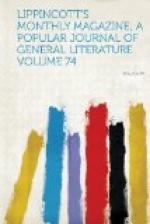[Illustration: HINDU TEMPLES NEAR POONA.]
But I did not care to linger in Poona. The atmosphere always had to me a certain tang of the assassinations, the intrigues, the treacheries which marked the reign of that singular line of usurping ministers whose capital was here. In the days when the Peishwas were in the height of their glory Poona was a city of a hundred and fifty thousand inhabitants, and great traffic was here carried on in jewelry and such luxuries among the Mahratta nobles. The Mahrattas once, indeed, possessed the whole of India practically; and their name is composed of Mahu, a word meaning “great,” and often to be met with in the designations of this land, where so many things really are great, and Rachtra, “kingdom,” the propriety of the appellation seeming to be justified by the bravery and military character of the people. They have been called the Cossacks of India from these qualities combined with their horsemanship. But the dynasty of the usurping ministers had its origin in iniquity; and the corruption of its birth quickly broke out again under the stimulus of excess and luxury, until it culminated in the destruction of the Mahratta empire in 1818. So, when we had seen the palace of the Peishwa, from one of whose balconies the young Peishwa Mahadeo committed suicide by leaping to the earth in the year 1797 through shame at having been reproved by his minister Nana Farnavese in presence of his court, and when we had visited the Hira-Bagh, or Garden of Diamonds, the summer retreat of the Peishwas, with its elegant pavilion, its balconies jutting into the masses of foliage, its cool tank of water, reposing under the protection of the temple-studded Hill of Pararati, we took train again for Bombay.
The Great Indian Peninsula Railway’s main line leads out of Bombay over the Ghats to Jabalpur, six hundred miles; thence a railway of some two hundred and twenty miles runs to Allahabad, connecting them with the great line, known as the East Indian Railway, which extends for more than a thousand miles north-westward from Calcutta via Patna, Benares, Allahabad, Cawnpore, Lucknow, Agra and Delhi. Our journey, as marked out by Bhima Gandharva, was to be from Bombay to Jabalpur by rail; thence by some slow and easy conveyance across country to Bhopal, and from Bhopal northward through Jhansi to Delhi and the northern country, thence returning by rail to Calcutta.




